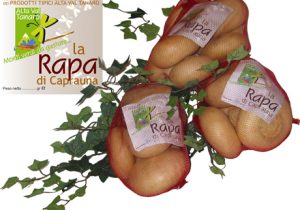
Name
Caprauna Turnip
Seal of quality
Slow Food aid
Description
The Caprauna turnip (Brassica rapa subsp. rapa) has a large flat- rounded root of a yellowish-white colour, and a sweet taste, the sweetness increasing with the intensity of the yellow colour. The root vegetable was traditionally sown on the terraces supported by dry stone walls after the corn harvest, and thanks to its high degree of resistance to low temperatures, it provided sustenance for the entire autumn. Cultivation in calcium-rich soils at altitudes of between 800 and 1500 m together with the presence of cereal stubble enhanced the growth and the sweetness of the root vegetable.
The seed is self-produced at a company level, by hanging and drying the inflorescence of the best plants specifically destined to seed production. From this same seed, there are two distinct varieties of turnip produced, the yellow variety which is sweeter and more highly valued, and the white variety which is less tasty.
Area of production
Communes of Caprauna and Alto (Upper Tanaro valley).
History
The Caprauna area features an incredible expanse of ancient terraces, which bear testimony to the flourishing agricultural activities of previous times. These terraces that are supported by dry stone walls, extend for up to a height of 1200 m making it possible to cultivate corn, barley, rye and oats. After the first cereal harvest, the farmers would sew the turnip seeds on the stubble that were later harvested during the winter season and sold at the markets of the Tanaro valley and nearby, where they were famed for their sweetness. The leaves, known as “gambe” in dialect ( dry plants) were burnt on the evening of S. Giovanni , in front of the houses and the ashes were then scattered over the entrance to keep ants away.
Now days there are no more than 130 residents in Caprauna, and the average age is of approximately 60. The initiation of a defensive measure, as part of the programmes of the public administrations involved, aims to promote a product that has indisputable organoleptic qualities, and should prove to be the start of a more extensive territorial and environmental programme. The aim being that of increasing turnip cultivation on the pre-existing terraces, and the recovery of the damaged ones, together with a series of initiatives aimed at providing incentives for those that intend to return to this type of cultivation as well as those who would simply want to return to Caprauna to live. The Caprauna turnip together with the other typical products of the Tanaro Valley, are supported by the Consortium for the promotion and enhancement of the typical products of the Upper Tanaro valley. That have adopted production principles and their own sales brand for the products that they represent.